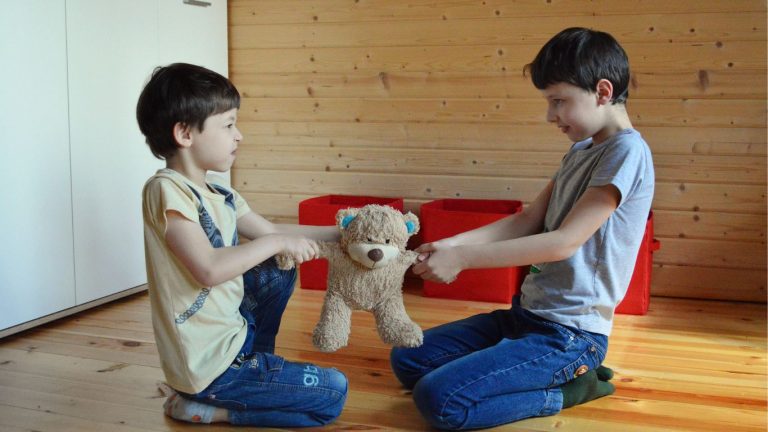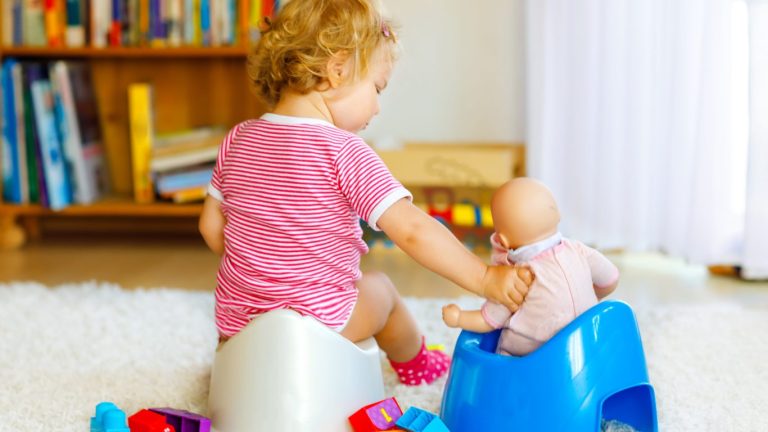It is a fact that around the time toilet training usually begins, children are starting to strive for more independence and beginning to test limits. This can make toilet training a stressful time for child and adult.
From age 18 months, it is very much a “me do it” phase and children want things to be done their way and in their time. This is why if there is too much stress or over emphasis on using the toilet it can very quickly become a negative experience for your child and turn into a ‘battle’.
So how do we make this a normal part of development?
Ten top tips for potty training
- Look for signs your child is ready for potty training. Is their nappy dry when you go to check (after two hours) or after a sleep? Are they noticing they are wet or have done a bowel motion? This may be shown through body language. They may be showing more interest in adults or siblings going to the toilet – a natural curiosity. Are they wanting to be independent and do things for themselves? While not essential it will help if they have some language skills to verbalise that they want to go to the toilet. Can they understand and follow simple one or two step instructions
- Have routines and equipment used in the process part of everyday life. Before beginning toilet training, have a potty sitting in the bathroom for several weeks beforehand so it becomes a normal part of the environment. This is the same with a step or toilet seat insert. They may want to sit on the potty with their clothes on: let them. They may surprise you and initiate using the things you provide for toilet training. Talk to your child about what they are for. Let them practise stepping up on the stool and sitting on the toilet. Again with their pants on if they like. Have them blow their nose and put the tissue in the toilet to flush as for some children the noise and sudden flushing can be scary.
- Equip them with the self-help skills needed. This includes getting pants on and off and washing hands. During early toileting, stick with simple clothes that make going to the toilet a quick and easy process. Avoid jeans, overalls, stockings and things with lots of buttons and zips. Developmentally boys may find it easier to sit and go to the toilet at first, standing and aiming often comes once they are confident. Encourage your child to take their time so their bladder is completely emptied at each time on the toilet.
- Offer choice and phrase conversations positively. How you talk about toileting with your child makes a big difference to their feeling of being in charge. Try asking “would you like to use the potty or the toilet?” “Would you like to use the step to get up to the toilet or would you like me to lift you up?” “It’s time for the toilet before we go out, do you want to sing a song or look at your book while on the potty?”For many children feeling like they have a choice makes a huge difference to their level of cooperation. Refrain from coming in and swooping your child up and quickly put them on the toilet without warning. We as adults don’t like to be suddenly and unexpectedly interrupted and told to do something and neither do children.
- Have your child part of the process and planning. Involve your child in choosing underwear or a new potty/toilet seat. Make a day of it and go to the shops to pick out some underwear with their favourite characters on it, or buy some stickers that they could decorate a potty with. Again it’s about making them feel involved in the process.
- Have toileting as part of the daily routine. Later children will recognise their own body signals and take themselves off to the toilet when needed. In the beginning you will need to initiate these times such as before bath time or after lunch, as well as watching for any signs through their body language. If these become regular times as part of the daily routine, children feel more secure as they know what’s happening next. You may get less resistance too if it becomes part of their routine. Try to avoid interrupting play if you can, as naturally children will be reluctant to stop in the middle of something fun to go to the toilet. If you can see they really need to go offer reassurance that they can return. Children often worry they will miss out or lose their toy if they go to the bathroom, so offer to put their Lego or other activity up onto the bench safe for their return, or put it near the open door to the bathroom where they can see it.
- Learn through play. Play is how children make sense of the world and process change. If you can, buy a dolls potty. If you are feeling really creative make one out of a box or container. Then bring in doll play about going to the toilet. Buy or look at your library for books about toileting for children. They are often done in a humourous way that children respond well to. “I want my potty” by Tony Ross is one example.
- Bring in some fun! – Talk about listening for the tinkle. We used to talk about the wees hiding in there if my daughter wanted to jump off after two seconds on the potty then she would shout ‘come out wee wees!” My own son when he started toilet training liked to listen for the splash of the poo and would talk about the big bomb and then clap his hands and make a big noise! Humour works well with children keeping things relaxed and positive.
- Focus on day time dryness first. While some children may be able to be dry at night, quite soon after day time control, many are physically not ready. Some may be dry during the day at 3 but not at night until 5 or 6. Getting used to drinking a medium sized cup of water in one go can train the bladder to be able to hold larger amounts of fluid rather than the habit of a water bottle that is sipped on over an hour or so. Include fibre, fruits and vegetables with lots of water to help bowel motions feel comfortable for your child.
- Be consistent and encouraging. Work together so Grandparents, caregivers, Kindergarten and home are all using the same positive approach. It is confusing for children if they wear underwear in one environment and nappies/pull ups in the other environment and it can slow down the process. Give praise and encouragement. Children naturally want to know that we are proud of them so show in your face and your words that you are proud.
Toilet training should be viewed as just another skill for your child to learn with your support. Years later it won’t matter if they were using the toilet independently at 2 years, 3 years or later; they will get there. What will matter is that they feel confident in their own abilities and independence, so take their lead and be positive.
Some useful articles and resources on toilet training
Find out more about toilet training for older children in Trouble with Potty Training and help for children that just won’t go in Potty Training your Children. We also discuss how to Potty Potty Train in Just one Week.
Try this toilet training method for quickly and easily potty training in as little as 3 days.





